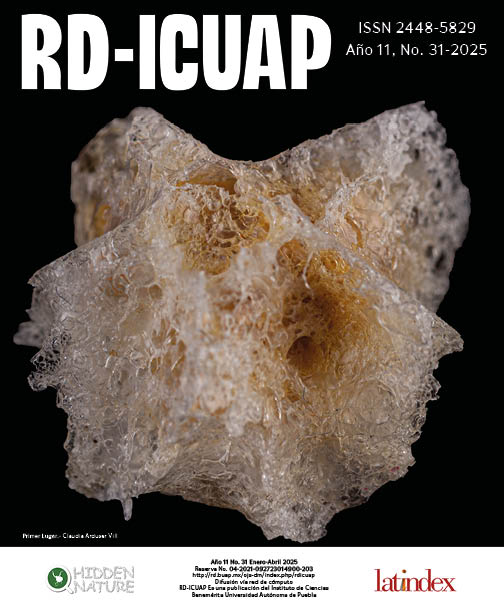TÉCNICA INNOVADORA PARA LA CAPTURA DE MICROPLÁSTICOS EN AGUAS CONTAMINADAS USANDO FIBRAS ÓPTICAS
DOI:
https://doi.org/10.32399/icuap.rdic.2448-5829.2025.31.1541Palabras clave:
Microplasticos, Fibra óptica, Trampa Thermo-Óptica, SaludResumen
En la actualidad, la contaminación por microplásticos representa un problema global con graves implicaciones para el medioambiente y la salud humana, ya que estas diminutas partículas se encuentran en cuerpos de agua en todo el mundo, desde océanos hasta fuentes de agua potable, amenazando a los ecosistemas acuáticos y la cadena alimentaria. Ante esta preocupación, se ha impulsado la búsqueda de soluciones innovadoras para capturar y eliminar eficazmente los microplásticos en aguas contaminadas. Este artículo introduce una novedosa técnica que utiliza fibra óptica, nanopartículas y luz láser para atraer y capturar microplásticos. Las nanopartículas metálicas son depositadas sobre la sección transversal de una fibra óptica y posteriormente calentadas para generar cambios graduales de temperatura que actúan como imanes virtuales, permitiendo la captura eficiente de los microplásticos. Esta innovación no solo facilita su identificación y análisis con técnicas ópticas, sino que también plantea la posibilidad de utilizarla para la purificación del agua, lo que podría contribuir significativamente a la protección del medioambiente y la salud pública. En resumen, el extremo de una fibra óptica con nanopartículas metálicas actúa como una trampa termo-óptica muy efectiva para atraer microplásticos, lo que la convierte en una opción prometedora para purificar el agua.
Citas
Amin, R. M., et al. (2020). Microplastic ingestion by zooplankton in Terengganu coastal waters, southern South China Sea. Marine pollution bulletin 150: 110616. https://doi.org/10.1016/j.marpolbul.2019.110616.
Andrady, A. L. and M. A. Neal (2009). Applications and societal benefits of plastics. Philosophical Transactions of the Royal Society B: Biological Sciences 364(1526): 1977-1984. https://doi.org/10.1098/rstb.2008.0304.
D’Avignon, G., et al. (2022). Microplastics in lakes and rivers: an issue of emerging significance to limnology. Environmental Reviews 30(2): 228-244. https://doi.org/10.1139/er-2021-0048.
Enders, K., et al. (2015). Abundance, size and polymer composition of marine microplastics≥ 10 μm in the Atlantic Ocean and their modelled vertical distribution. Marine pollution bulletin 100(1): 70-81. https://doi.org/10.1016/j.marpolbul.2015.09.027.
Koelmans, A. A., et al. (2015). Nanoplastics in the aquatic environment. Critical review. Marine anthropogenic litter: 325-340. https://link.springer.com/chapter/10.1007/978-3-319-16510-3_12.
Koelmans, A. A., et al. (2017). All is not lost: deriving a top-down mass budget of plastic at sea. Environmental Research Letters 12(11): 114028. https://doi.org/10.1088/1748-9326/aa9500.
Li, Y., et al. (2020). Occurrence, removal and potential threats associated with microplastics in drinking water sources. Journal of Environmental Chemical Engineering 8(6): 104527. https://doi.org/10.1016/j.jece.2020.104527.
Martin, L. M., et al. (2022). Testing an iron oxide nanoparticle-based method for magnetic separation of nanoplastics and microplastics from water. Nanomaterials 12(14): 2348. https://doi.org/10.3390/nano12142348.
Mintenig, S. M., et al. (2019). Low numbers of microplastics detected in drinking water from ground water sources. Science of the total environment 648: 631-635. https://doi.org/10.1016/j.scitotenv.2018.08.178.
Nalupurackal, G., et al. (2022). A hydro-thermophoretic trap for microparticles near a gold-coated substrate. Soft matter 18(36): 6825-6835. https://doi.org/10.1039/D2SM00627H.
Ortega-Mendoza, J., et al. (2019). Generating micropatterns onto the core of an optical fiber end with nanoparticles using fiber modes. Laser Physics Letters 16(4): 045105. https://doi.org/10.1088/1612-202X/ab0c88
Pan, Z., et al. (2019). Prevalence of microplastic pollution in the Northwestern Pacific Ocean. Chemosphere 225: 735-744. https://doi.org/10.1016/j.chemosphere.2019.03.076.
Park, D. H., et al. (2022). In Situ Fluorescent Illumination of Microplastics in Water Utilizing a Combination of Dye/Surfactant and Quenching Techniques. Polymers 14(15): 3084. https://doi.org/10.3390/polym14153084.
Rani, M., et al. (2023). A Complete Guide to Extraction Methods of Microplastics from Complex Environmental Matrices. Molecules 28(15): 5710. https://doi.org/10.3390/molecules28155710.
Rico, A. and P. J. Van den Brink (2015). Evaluating aquatic invertebrate vulnerability to insecticides based on intrinsic sensitivity, biological traits, and toxic mode of action. Environmental Toxicology and Chemistry 34(8): 1907-1917. https://doi.org/10.1002/etc.3008.
Wagner, M. and S. Lambert (2018). Freshwater microplastics: emerging environmental contaminants?, Springer Nature. https://library.oapen.org/handle/20.500.12657/42902.
Descargas
Publicado
Cómo citar
Número
Sección
Licencia
Derechos de autor 2025 RD-ICUAP

Esta obra está bajo una licencia internacional Creative Commons Atribución-NoComercial-SinDerivadas 4.0.
Definir aviso de derechos.
Los datos de este artículo, así como los detalles técnicos para la realización del experimento, se pueden compartir a solicitud directa con el autor de correspondencia.
Los datos personales facilitados por los autores a RD-ICUAP se usarán exclusivamente para los fines declarados por la misma, no estando disponibles para ningún otro propósito ni proporcionados a terceros.


